|
New Developments in Digital Circuitry and Input/Output Equipment
The recent Electronic Computer Exhibition held at Olympia marks the end of the first decade of computer development in Great Britain. In these ten years the digital computer has emerged from the chrysalis of university and Government laboratories to become a fully developed and engineered commercial product. There are now over a hundred working installations in this country. Of these the greater proportion consists of scientific computers, for the era of business data processing is only just getting under way (with the notable exception of Lyons Electronic Office, operating successfully since 1953).
From the electronic engineering point of view it is, of course, the thermionic-valve computer which has now reached the state of a reliable commercial product. A great deal of money has been spent on research and, although everybody knows that transistors are the ideal components for digital computer circuitry, it is likely that the valve machine for which regular production lines have now been set up will continue to dominate the market for a good many years to come. This situation may eventually be modified now that several transistor computers have been developed and put on view at the Exhibition. But, even so, the valve computer will have the advantage of lower price for some considerable time.
There is probably no need to remind readers of this journal of the advantages of the transistor for use in the large masses required for digital computers. Being small, it makes possible machines of greatly reduced size. Requiring no heater it reduces the problem of cooling, avoids the danger of heat affecting other components, simplifies the power supplies, and generally allows the components to be packed tighter together. As for reliability, this is a slightly unknown factor, but it is likely that the transistor will prove at least as reliable as the valve and probably longer-lived.
The main limitation of the transistor so far has been its slow speed of response compared with the valve. In the past this has restricted its operation to pulse repetition frequencies up to about 100 kHz, whereas a good many valve computers work at PRFs of several megacycles. Some of the latest transistor machines to be developed are using high-frequency alloyed-junction transistors of the OC44 and OC45 types, and these are now making possible pulse rates in the range of 100 kHZ-1 MHz. When surface-barrier, micro-alloy and other advanced high-frequency types find their way into the computing field the pulse rates will rival those of valve computers and probably exceed them. Indeed, once the problem of obtaining high speed of response is solved (as it will be) the transIstor will show a distinct advantage over the valve, because of its inherently low input and output impedances, which will reduce the effects of circuit capacitance on fast pulse rise times.
For some applications where high-speed computing is not required the present available LF transistors are quite adequate. An example of this occurs in the exciting new sphere of process control by computers, which manufacturers of data processing equipment and control gear are just beginning to explore jointly. The idea is that the computer is incorporated directly into the control system, taking its input in turn from various measuring transducers distributed about the industrial plant (via analogue/digital converters) and giving outputs which are used to actuate servo-mechanisms for controlling the plant.
Ferranti process control computer with plug-in printed-circuit cards on the left and control panel and programme trays on the right.
Two machines intended for this type of work were shown at the Exhibition. One, made by Ferranti, is being currently investigated as a possible means for the control of boilers during start-up and shut-down operations. A National-Elliott machine is to be used in a data processing and information system for application to a nuclear reactor of the UKAEA Both are stored-programmed computers and are quite small, as can be seen from the illustrations. The significant point is, though, that the sampling of measurement points in the industrial control system is not done so rapidly that the computing has to be performed in a continuous high-speed stream. In fact, there are pauses between each burst of computing which could possibly be used for other work. As a result the machines have been designed to work in the serial mode (pulses representing binary digits by their relative positions in time), and it is not necessary for the pulse rate, which determines the speed of computing in the serial mode, to be unduly high. Thus, although these machines are operating in what is known as real time, the real time is, in fact, rather slow.
The Ferranti computer actually has a PRF of 500 kHz, and performs addition, subtraction, and other simple operations such as transfer of numbers in 24 μsec. More complex operations take longer. The length of the numbers, or word length, is 10 binary digits (or 20 optional). Each step or instruction in the stored programme consists of a pattern of wiring connections and these patterns are set up by hand as rows of plugs in plug-boards, which are held in trays on the right-hand side of the machine (see picture). Altogether 500 programme steps are available and the computer scans them in turn. They are single-address instructions, that is, each instruction specifies in coded form the address or storage location of the next number to be transferred into the accumulating register in which the arithmetic operation is to be performed. The instruction also specifies in coded form what arithmetic operation is to be performed. When this is completed the computer automatically selects the next instruction in the plug-board programme.
The storage locations referred to are provided by a storage system of the magnetic-core matrix type using tiny ferrite cores with rectangular hysteresis loops. This has a capacity of 256 numbers of 10 binary digits each, and the interesting point about it is that the windings driVing the cores from one state of remanent magnetization to the other are energized by power transistors of the new OC23 type. Transistors hitherto available have not had the required combination of high collector current output and high alpha cut-off frequency necessary for this work, but the OC23 will deliver pulses of about 1 Amp and has a cut-off frequency of 2.5 MHz.
Logical circuitry in the computer is similar to the larger Pegasus valve machine made by Ferranti. It is based on OR and NOT gate type circuits formed by semiconductor diodes and transistor inverters. The two-state elements used extensively in binary digital computers to provide short-term storage registers are formed by transistor Eccles-Jordan trigger circuits. For this kind of operation the OC44 transistor is used. Pulse rise times are about 50 μSec. The computer works on power supplies of +6 V, -6 V and -24 V and its total consumption is only 250 Watts.
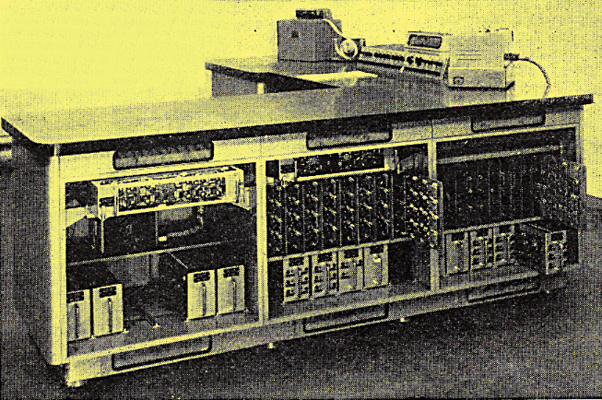
National-Elliott 802 desk type computer with covers removed to show printed-circuit boards and the core matrix store (black box).
In the National-Elliott 802 machine the digit pulse rate is 166.5 kHz and the word length is 33 binary digits. Addition, subtraction and 46 other orders are performed in 612 μSec each. It is again a single-address machine, but the programme of instructions is normally fed in by punched paper tape to be held in the magnetic-core matrix store (1,020 words capacity).
The logical circuitry is based on OR and NOT elements as before, but here two-state magnetic ferrite cores with various sets of input windings and a single output winding are used instead of the diode circuits. According to the logical pattern of input digit pulses applied to the input windings, each core is set into one state or the other, corresponding to 0 or 1 in binary notation, by the coincident magnetic fields. This happens in the first 3 μSec half of the 6 μSec digit-pulse period. A so-called shift or trigger pulse is then applied to an additional input winding in the second 3 μSec half of the digit-pulse period, and the effect of this is either to switch the core or leave it as it is-depending on how it has been set by the original digit pulse inputs. As a result of this action the output winding either produces a pulse or a space (absence of a pulse), and this is where the transistor enters the picture-to amplify, regenerate and pass on the output pulse to another winding on another core
Thus the magnetic-core/transistor circuits operate in two phases-the set phase, when the cores are switched into one state or the other, 0 or 1 by the input signals, and the shift phase, when the information on this state is made to appear at the output. The action is of necessity slower than the diode logical circuits, where all the switching occurs instantaneously, and in any case it is limited by the time-constant of the windings and magnetic core, which normally only allow operation at PRFs up to about 100 KHz. Hence the slower calculating speed of this machine compared with the Ferranti computer
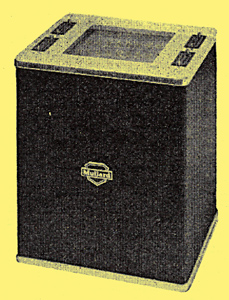
Magnetic-core matrix store (Mullard) used in many computers for immediate-access storage. The box contains a stack of matrix planes.
In spite of this inherent speed limitation the magnetic-core/transistor combination is likely to prove very popular as a circuit element in digital computers. The magnetic cores, as well as being small and robust have a life which is probably infinite for all practical purposes, and while they are holding binary information by one state of remanent magnetization or the other they are not consuming power. Since they are inherently slow it is possible to use relatively inexpensive AF transistors for switching them, and in the National-Elliott 802 machine the ubiquitous OC72 performs this function. A basic computing element of magnetic core, transistor and one resistor mounted on a printed circuit is illustrated below.
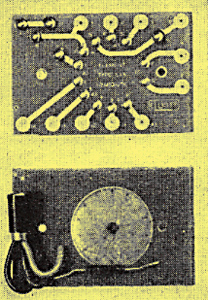
A basic computing element of the machine, with transistor, core and resistor.
The speed of operation of magnetic-core/transistor computing circuits can be increased by working in the parallel mode instead of the serial mode. This means that all the digIts of, say, a 32-digit number appear as pulses or spaces on 32 wires simultaneously, instead of in a time sequence on just one wire. Such a technique has been adopted in the Emidec 1100 digital computer shown by EMI Electronics, a somewhat larger machine than those mentioned previously. The computer uses magnetic cores in combination with OC72 AF transistors and OC41, OC42 and OC45 high-frequency types. It has a high-speed immediate access magnetic-core matrix store (1,024 words capacity) driven by OC23 transistors, together with supplementary magnetic-drum stores each holding 16,384 words. These drums write and read digital information in sequential form, so special serializer and parallelizer circuits have to be placed between them and the parallel computing circuits. The word length, incidentally, is 36 binary digits, and numbers are transferred to and from the electro-mechanical input and output units in 6 lots of 6 binary digits. Instructions are of the two-address type
Although the basic pulse rate of the Emidec 1100 is even lower than that of the National-Elliott 802 (actually 112 kHz) the speed of computing, owing to the parallel mode of operation, is a good deal faster. Addition, subtraction and other similar operations take about 120 μSec, in fact. This speed is necessary, however, where it is not in the National-Elliott, because the Emidec is intended for entirely different applications. Moreover, the speed has to be paid for in the greater complexity of equipment necessary with parallel operation. The size of the Emidec machine is considerably smaller than that of eqUivalent valve machines and the power consumption of the computer proper is only 2 kW -incidentally, it runs off car batteries!
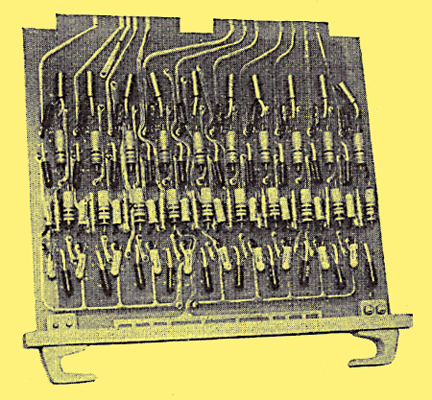
Plug-ln prlnted-clrcult card for the Emidec 1100 magneticcore/transistor computer.
EMI Electronics were also showing a very much faster machine, the Emidec 2400, which uses diodes and HF transistors for the logical circuits and operates at the high pulse rate of 1 MHz. Magnetic cores are only present in the matrix store. Another, somewhat uncommon, quick-access store in the machine (64 words capacity) is formed by combinations of capacitors and diodes. Again, instructions are of the two address type and the machine operates in the parallel mode. But the average time for addition and similar operations in this computer is only 0.6 μSec-about 200 times faster than the Emidec magnetic-core/transistor machine
Output devices at the show
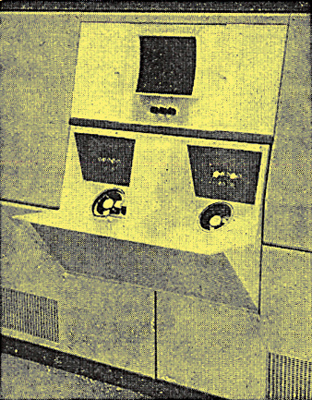
Control desk of the Solartron ERA character recognizer which reads documents such as till rolls of up to 300 characters per sec
Such high speeds of operation are now becoming quite common in digital computers. They have raised the very difficult problem, which is always being quoted nowadays, that the electro-mechanical output equipment cannot keep up with the electronic speed of the computing circuits and is, in fact, causing a bottleneck in the production of computed results. Output equipment usually consists of card punches, paper tape punches, line-at-a-time printers, or electric typewriters, and in practice various combinations of these are used
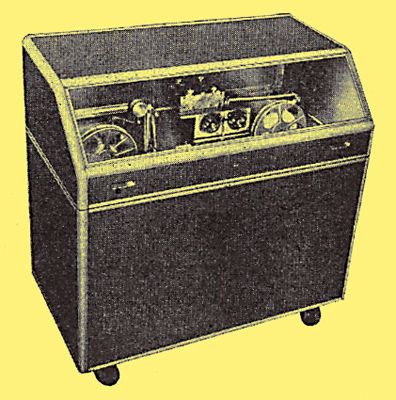
Creed high-speed paper tape punch.
Great efforts are being made to remove the bottleneck by developing existing types of equipment and inventing new kinds. At the Exhibition one of the most outstanding examples of development in existing methods was the Creed 3000 high-speed paper tape punch. This operates at 300 characters a second (a character being a row of holes across the tape), which is about ten times as fast as most of the tape punches currently available. To achieve such a high speed, start-stop operation has been confined to very light parts, the movements of which have been kept very small. Heavier components are arranged to have continuous smooth motions. Higher grade materials are used, tolerances are closer and the lubrication has been improved over previous machines
Amongst the more unconventional output devices, a machine which is beginning to establish itself very firmly is the Powers-Samas Samastronic page printer. This has abandoned the conventional method of printing from type fonts and uses reciprocating styli to build up the letters and figures from patterns of inked dots. As a result it can print on a page at the rate of 300 lines per minute with 140 characters in each line-compared with the 100 lines a minute or so of some of the more conventional page printers. A storage system holds the necessary information for constructing 50 different characters and these are called up automatically by code signals fed in from punched cards
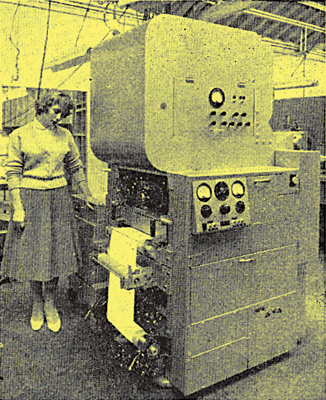
Xerographic high-speed output printer made by Rank Precision Industries. The electronic equipment is housed in a separate cabinet.
Probably the most spectacular of the high-speed computer output devices on show was the Xeronic page printer demonstrated by Rank Precision Industries. This dispenses altogether with mechanical methods of making marks on paper, but records photographically, by the dry xerographic process, characters written on the screen of a CRT. It can print at the staggeringly high speed of 1,500 lines a minute with 128 characters in each line on 13-inch wide paper, and is being developed to work up to 3,000 lines a minute
The machine is a combination of an existing xerographic copying machine called the Copyflo (made by Rank-Xerox Ltd.) and an electronic character-generating equipment which is housed in a separate cabinet (except for the CRT). Special CRT's have been developed in the USA which form characters by passing the electron beam through stencils and focusing the resulting patterns on to the screen, but these are rather expensive items. The interesting point about the Xeronic machine is that it uses a normal instrument-type CRT and the characters are formed rather like Lissajous figures by applying deflection signals to the X and y plates. These deflection signals are produced by applying suitable waveforms to passive networks, and the results displayed on the screen (capital letters) are of excellent quality and clarity
Other electronic circuits are used to decode the binary input signals which specify the required characters and also to decode input instructions relating to the layout of the printed data. These layout instructions include such functions as horizontal and vertical tabulation, line feed-(equivalent to carriage return on a typewriter), spacing and stopping, and selection of forms and headings as may be required for bills, invoices and so on. Tabulation can be pre-set manually by a plug-board, while the size of the characters printed can be varied by adjusting the gain controls of the deflection amplifier. Transistors are used extensively throughout the machine
The actual xerographic process of recording the characters displayed on the CRT is centred around a large rotating drum with a coating of selenium. To begin with the drum surface receives an electrostatic charge from a wire grid, and this is retained as long as the drum is in darkness. Next the images from the CRT are focused on the drum, and these modify the charge on the selenium to form a charge pattern corresponding to the characters displayed. The resultant electrostatic image is developed by showering over the drum thermo-plastic powder which has been charged oppositely to the pattern of characters on the selenium so that it adheres to the electrostatic image. After this the powder image is transferred by application of an other electrostatic charge to the band of 13-inch paper, which is in continuous contact with the face of the drum and moving at the same speed. Finally the powder image is fused permanently to the paper by passing under a heating element. At the end of the process the drum is cleaned and is then ready for further recording action.
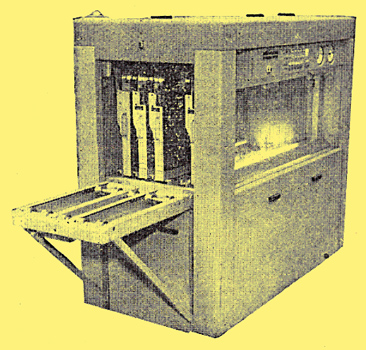
High-speed endless-loop magnetic-tape unit demonstrated by STC. Three tape magazines are shown in the frame but five can be fitted.
At the Exhibition the Xeronic printer was shown operating from an input from a high speed endless-loop tape machine displayed by STC. This machine runs at 100 inches per second and information is stored in blocks in several parallel tracks at a packing density of 250 binary digits to the inch. In this application each block (containing a maximum of 500 binary digits) was transferred serially to a staticizer or static store, after which each character of 5 binary digits was transmitted in parallel form over a 5-wire line to the printer. The tape transport mechanism was automatically controlled by the paper feed of the Xeronic machine.
Speeds of 100 inches/sec are now quite common for magnetic tape storage systems. One machine displayed by EMI Electronics runs at 200 inches/sec stops and starts in less than 5 milliseconds and reverses in less than 7 milliseconds. This rapid type of operation is necessary to reduce the access time to information which, by the very nature of magnetic tape, has to be stored in sequential fashion. Most of the machines developed recently have two driving capstans rotating continuously in opposite directions and the tape is sucked rapidly into contact with either one or the other by a vacuum system under the control of switching signals from the computer. Two tape loops or reservoirs between the capstans and the spools isolate the tape drive from the inertia of the heavy spools, and the reservoirs are kept filled with constant lengths of tape by a servo system controlling the spool drive motors. To avoid wear the tape runs out of contact with the reading/wring heads.
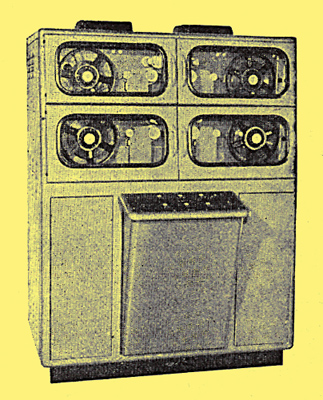
Decca magnetic-tape storage equipment using two half-inch tapes running at 100 inches/sec. The capacity is 23 million binary digits on each 2,400-ft tape.
|